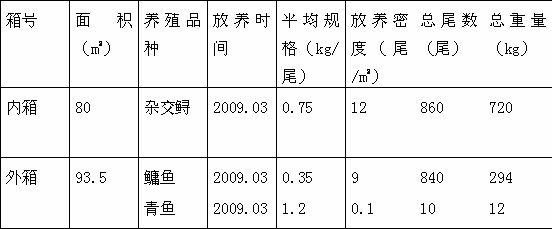Environment-friendly method for culturing fish by using net cages
A net cage fish farming, net cage technology, applied in fish farming, application, climate change adaptation, etc., can solve the problems of fish grabbing food, taking food, affecting the inner hole and water flow exchange of the net cage, water pollution, etc. Achieve the effects of reducing the impact on the water environment, saving manual cleaning costs, and reducing feed waste
- Summary
- Abstract
- Description
- Claims
- Application Information
AI Technical Summary
Problems solved by technology
Method used
Image
Examples
Embodiment 1
[0026] Take a set of 4+1 cage fish farming method as an example:
[0027] 1. The set-up cage is composed of 5 cages with inner and outer double-layer set cages, including a large cage, the outer cage and 4 small cages, the inner cage. The size of the large cage is 11m×8.5 m×6m (length×width×depth), mesh size 2a=8cm; size of small cage is 5m×4m×4m (length×width×depth), mesh size 2a=6cm, 4 small nets The cages are evenly distributed in the large net cages in the shape of a "field", and the "ten"-shaped gap in the middle of the large net cages is set up as a sidewalk. Two 15w energy-saving lamps are set up on the walkway. The cage frame is built with 50mm diameter galvanized steel pipe and fasteners. Oil drums are placed around the large net cage and on the middle aisle as floats, bagged pebbles are used around the bottom of the large net cage as sinkers, and small net cages are supported by a 3.5m×4.5m round steel frame at the bottom, and 2a=0.5cm The dense mesh sheet is used a...
Embodiment 2
[0047] Take a set of 1+1 net cage fish farming method as an example:
[0048] 1. The set cage is composed of 2 cages, the inner and outer double-layer set cages, including a large cage, an outer cage and a small cage, the inner cage. The size of the large cage is 7m×5m× 5m (ie length × width × depth), mesh size 2a = 8cm; small cage size 6m × 4m × 3m (ie length × width × depth), mesh size 2a = 3cm. The frame of the net cage is built with galvanized steel pipes with a diameter of 50 mm and fasteners. The empty oil drums are placed around the large net cage as floats, and bags of pebbles are used around the bottom of the large net cage as sinkers. The small net cages use 2a=0.5cm dense mesh The whole bottom feed table is made of slices.
[0049]2. Breeding varieties and specifications: the species stocked in the inner net cage is the southern largemouth catfish, the average size is 30g / tail, and the stocking density is 25 fish / m 2 , a total of 600 southern largemouth catfish we...
Embodiment 3
[0053] Take a set of 2+1 net cage fish farming method as an example:
[0054] 1. The set-up cage is composed of 3 cages with inner and outer double-layer sets of cages, including a large cage, an outer cage and a small cage, which is the inner cage. The size of the large (outer) cage is 9m ×5m×5m (i.e. length × width × depth), mesh size 2a=8cm; small (inner) cage size is 4m×4m×3m (i.e. length×width×depth), mesh size 2a=3cm. The frame of the net cage is built with galvanized steel pipes with a diameter of 50 mm and fasteners. The empty oil drums are placed around the large net cage as floats, and bags of pebbles are used around the bottom of the large net cage as sinkers. The small net cages use 2a=0.5cm dense mesh The whole bottom feed table is made of slices;
[0055] 2. Stocking species and specifications: the stocking species in the inner cage is channel catfish, the average size is 55g / tail, and the stocking density is 110 fish / m 2 , a total of 3,520 channel catfish were...
PUM
 Login to View More
Login to View More Abstract
Description
Claims
Application Information
 Login to View More
Login to View More - R&D
- Intellectual Property
- Life Sciences
- Materials
- Tech Scout
- Unparalleled Data Quality
- Higher Quality Content
- 60% Fewer Hallucinations
Browse by: Latest US Patents, China's latest patents, Technical Efficacy Thesaurus, Application Domain, Technology Topic, Popular Technical Reports.
© 2025 PatSnap. All rights reserved.Legal|Privacy policy|Modern Slavery Act Transparency Statement|Sitemap|About US| Contact US: help@patsnap.com


